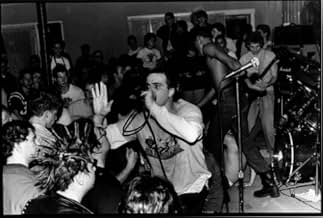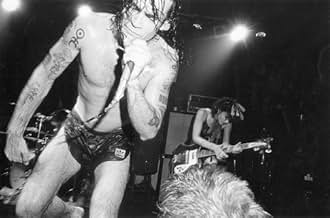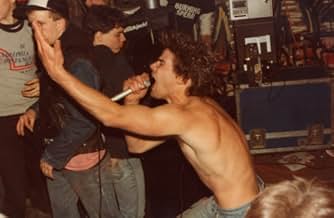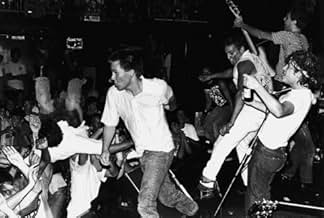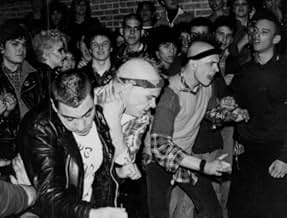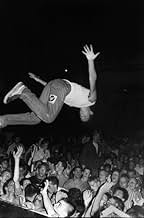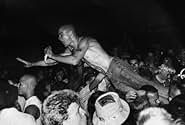IMDb-BEWERTUNG
7,3/10
3687
IHRE BEWERTUNG
Füge eine Handlung in deiner Sprache hinzuThe History of American Punk Rock 1980-1986The History of American Punk Rock 1980-1986The History of American Punk Rock 1980-1986
James Drescher
- Self
- (as Jimmy Gestapo)
Joe Keithley
- Self
- (as Joey 'Shithead' Keithley)
David Markey
- Self
- (as Dave Markey)
Empfohlene Bewertungen
Fans of this short window in time of musical history will surely enjoy it for its nostalgic merit alone. The footage is raw and accurately depicts the dingy and often violent world of Post "Germs, Sex Pistols" and Pre-metal years of hardcore. Many important bands of that era were not depicted in the film for various legal reasons IE: The Dead Kennedy's, and The Misfits, but the variety of bands presented is a noble effort. Surprising to me was what I considered a LACK of music in the film, as most of it came in the form of the final ten seconds of a songs performance, then cutting into the next scene. The film IS about music so it's not like there isn't any, however I would have enjoyed more extended live footage. My harshest criticism of the film is that it simply shrinks away as to the real explanation of how this movement really came to an end. While it glorifies many great bands that created some extremely potent and visceral music, it ultimately brushed aside why the hardcore scene seemed to sputter and almost vanish. The film near its summation briefly touches upon the influence of heavy metal and how some bands evolved into that new sound. They seem to suggest that the "atmosphere" had changed but in reality the bands changed. Kids showed up a year later and all their favorite bands had grown long hair and seemed to be interested little in their hardcore roots. Sad but true.. but this was a genre praised for its dedication to "Doing It Yourself" but in the end they chose to find a way to pay the bills instead. I have never faulted bands for deciding they wanted to eat more than a package of Dorrito's in the back of a tour van, and I do not view metal as a lesser form of art, but the fact remains that the bands create the music, which in turn produces an environment. I was all too happy to indulge in the personal trip down memory lane, but I would have liked a more probing response as to its demise. I have to review this film positively because I am biased as to the musical content and to the time in which it represents, but to omit that money and industry influence is what truly ruined this scene,(As in most others due to over exposure, parody and more seemingly lucrative musical paths) is a strange and unsatisfying oversight. Having just praised its unyielding, anti-conformist roots I was then expected to forget it ever happened. As I stated all in all it's an absorbing film and a greatly accurate depiction of a highly influential point in the musical landscape. It should be viewed if for no other reason than its tribute to the contribution that American Hardcore had to musical history.
This film puts you on the stage with (almost) all the protagonists of the scene. Now, I saw the efforts in the production: many interviews, many concerts, however, in the end, I cannot hide that it's remained in me a feeling of disappointment. There are many, too many bands ignored in this documentary that, according to its presentation, should talk about history of hardcore in the USA. Well, for example, I haven't heard of the Dead Kennedys even once. This is only one of the many absences (for me, the worst) that have petrified me. It's a good film and everyone who like this musical genre should watch it in my opinion, but what a pity.
"Ameican Hardcore," is a pretty good documentary for those even a bit interested in the genre. Personally I found it heavily lacking in a number of departments. The film itself was put together pretty well over all and moves along at a good pace. What is lacking though is the appreciation of the entire other side of the West Coast scene. Most of the bands from San Francisco, or who centered themselves from S.F. were not covered at all. Obviously someone did not want to include Jello Biafra and DK, but whatever, they were there and they were important to the scene. Those from the mid-west probably felt a bit slighted by the fact that the Crucif*cks were not included as well. Way to many major bands were not even mentioned and it was very irritating. Overall this documentary was just okay. I was expecting much more considering that the book "American Hardcore" was quite a bit more thorough overall.
Just came out of a preview screening of this fine film here at the Natfilm festival in Copenhagen, Denmark! In short, 'American Hardcore' lives up to the expectations: Made in a D.I.Y. fashion befitting its' subject, it gives you an excellent overview of the first wave of American hardcore music, nicely balancing the violence that characterized the early days with the positive message that came out of it.
You'll get to see lots and lots of never-seen-before amateur footage from (really) early hardcore shows, interwoven with many, many, many excellent interviews with key figures from the scene.
Fact is, the filmmakers have managed to dig up pretty much everybody who was a nobody back in the day: Where one could have expected a long line of New York art critics, psychologists, social anthropologists and the like yakitiyaking away about form and substance, with perhaps a single Henry Rollins getting to represent the "hardcore punk subculture" as a whole, instead what you get is a literal who's-who of early American hardcore: You've got your Gang Green and your Circle Jerks, your SS Decontrol and your Jerry's Kids, your Negative F/X and your Cro-Mags, and so on and so forth.
On a side-note, some personal favorites will inevitably be missing from any such line-up -- yours truly specially misses Choke from Slapshot, Billy Milano from S.O.D., and Paul Bearer from Sheer Terror -- but that goes with the territory.
A bigger fault, perhaps, lies in the radically negative view one gets of what happened next. Towards the end of the film you're bombarded with clip after clip of hardcore veterans telling you that after '86, it was all over. Granted, what happened next falls outside of the framework of this movie (it specifically deals only with the years 1980-1986) and to make it sound like if it all actually ended in '86 makes for good drama -- but of course in fact it just isn't true.
In '88 you had the Gorilla Biscuits, Youth Of Today, Bold, Judge, and so on and so forth, and during the 90's, well, the thing kinda went on and on, evolving or degenerating depending on how you see things. In the eyes of purists perhaps what came after '86 doesn't count -- but if so, it would have been nice to hear something said about it, to hear these guys explain what it is about, say, Integrity or Floorpunch or Catharsis or His Hero Is Gone or Good Clean Fun that makes them so decidedly un-hardcore.
But why whine about such wee little things? All in all, the film is an excellent piece of documentary about the finest underground movement in music anywhere in the world between Roky Erickson came out of the asylum in the 70's and the churches burned in Norway in the 90's!
You'll get to see lots and lots of never-seen-before amateur footage from (really) early hardcore shows, interwoven with many, many, many excellent interviews with key figures from the scene.
Fact is, the filmmakers have managed to dig up pretty much everybody who was a nobody back in the day: Where one could have expected a long line of New York art critics, psychologists, social anthropologists and the like yakitiyaking away about form and substance, with perhaps a single Henry Rollins getting to represent the "hardcore punk subculture" as a whole, instead what you get is a literal who's-who of early American hardcore: You've got your Gang Green and your Circle Jerks, your SS Decontrol and your Jerry's Kids, your Negative F/X and your Cro-Mags, and so on and so forth.
On a side-note, some personal favorites will inevitably be missing from any such line-up -- yours truly specially misses Choke from Slapshot, Billy Milano from S.O.D., and Paul Bearer from Sheer Terror -- but that goes with the territory.
A bigger fault, perhaps, lies in the radically negative view one gets of what happened next. Towards the end of the film you're bombarded with clip after clip of hardcore veterans telling you that after '86, it was all over. Granted, what happened next falls outside of the framework of this movie (it specifically deals only with the years 1980-1986) and to make it sound like if it all actually ended in '86 makes for good drama -- but of course in fact it just isn't true.
In '88 you had the Gorilla Biscuits, Youth Of Today, Bold, Judge, and so on and so forth, and during the 90's, well, the thing kinda went on and on, evolving or degenerating depending on how you see things. In the eyes of purists perhaps what came after '86 doesn't count -- but if so, it would have been nice to hear something said about it, to hear these guys explain what it is about, say, Integrity or Floorpunch or Catharsis or His Hero Is Gone or Good Clean Fun that makes them so decidedly un-hardcore.
But why whine about such wee little things? All in all, the film is an excellent piece of documentary about the finest underground movement in music anywhere in the world between Roky Erickson came out of the asylum in the 70's and the churches burned in Norway in the 90's!
Too young for hardcore and too young for grunge, I had to learn about most of the bands in Paul Rachman's documentary American HARDCORE after their demise or during their declining years. The emptiest screening I attended at the festival, Rachman covers the oft-overlooked hardcore music scene of the early 1980s via a montage of maps, concert footage, and talking head interviews. Feeling like it was edited with a food processor, American HARDCORE does a fair job of cracking the lid on the hardcore scene but doesn't come close to presenting the material in any kind of cohesive way.
While the footage and photos of these myriad classic bands are fun to see (and the music is a blast), the film's narrative thrust is a muddled mess and some bands are conspicuously missing (old cliques die hard?). Hopefully a soundtrack will come from this.
While the footage and photos of these myriad classic bands are fun to see (and the music is a blast), the film's narrative thrust is a muddled mess and some bands are conspicuously missing (old cliques die hard?). Hopefully a soundtrack will come from this.
Wusstest du schon
- WissenswertesDespite this movie talking about how Reagan's presidency gave inspiration to the whole hardcore punk scene, New York Hardcore Punk band Reagan Youth is nowhere to be heard in this documentary.
- VerbindungenFeatures Urban Struggle: The Battle of the Cuckoo's Nest (2008)
- SoundtracksPay to Cum
Written by H.R. (as P. Hudson), Gary 'Dr. Know' Miller (as G. Miller),
Darryl Jenifer (as D. Jenifer), Earl Hudson (as E. Hudson)
Performed by Bad Brains
Caroline/EMI Records
© Bad Brains Publishing (ASCAP) 1979
Used by Permission
Top-Auswahl
Melde dich zum Bewerten an und greife auf die Watchlist für personalisierte Empfehlungen zu.
- How long is American Hardcore?Powered by Alexa
Details
- Erscheinungsdatum
- Herkunftsland
- Offizieller Standort
- Sprache
- Auch bekannt als
- American Hardcore: The History of American Punk Rock 1980 - 1986
- Drehorte
- Produktionsfirmen
- Weitere beteiligte Unternehmen bei IMDbPro anzeigen
Box Office
- Bruttoertrag in den USA und Kanada
- 279.665 $
- Eröffnungswochenende in den USA und in Kanada
- 18.102 $
- 24. Sept. 2006
- Weltweiter Bruttoertrag
- 376.057 $
- Laufzeit1 Stunde 40 Minuten
- Farbe
- Sound-Mix
- Seitenverhältnis
- 1.85 : 1
Zu dieser Seite beitragen
Bearbeitung vorschlagen oder fehlenden Inhalt hinzufügen

Oberste Lücke
By what name was American Hardcore (2006) officially released in India in English?
Antwort

